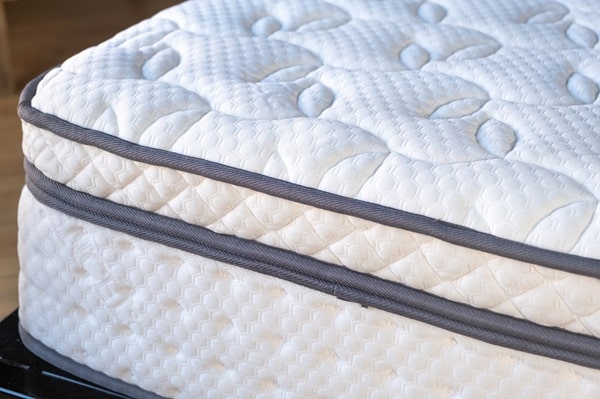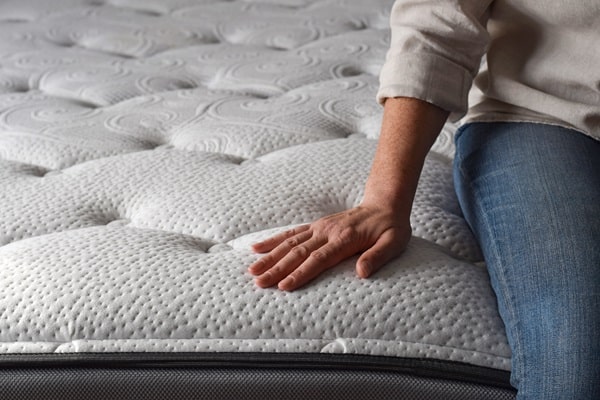Selecting the right mattress is crucial for ensuring a good night’s sleep, especially for back pain patients. The wrong mattress can exacerbate back problems, leading to a cycle of discomfort and poor sleep. Conversely, the right mattress can alleviate pain, support spinal alignment, and enhance sleep quality. This guide will navigate various considerations such as sleep position, mattress firmness, types and materials, size, durability, budget, and the importance of trying before buying. With the many options available, choosing the perfect mattress might seem daunting.
Contents
Understanding Your Sleep Position

Sleep position is critical in selecting a mattress, as it directly influences spinal alignment. Back sleepers generally require a firmer mattress to maintain the spine’s natural curve. In contrast, side sleepers might benefit from a softer surface that can cushion the shoulders and hips, promoting alignment. Stomach sleepers often recommend a medium-firm mattress to prevent the abdomen from sinking too deeply, which could misalign the spine.
Recognizing personal sleeping habits and preferences is the first step toward narrowing mattress options. A medium-firm mattress often provides balanced support and comfort for mixed sleepers who change positions throughout the night. Considering these aspects is essential, as the right choice can significantly impact sleep quality and spinal health.
The Role of Mattress Firmness

Mattress firmness is pivotal in back support and overall comfort during sleep. Firmness levels range from soft to very firm, affecting how well a mattress can align the spine and relieve pressure points. Individuals with back pain might find that a medium- to medium-firm mattress offers the ideal blend of support and cushioning, facilitating spinal alignment and evenly distributing weight.
Body weight and personal preference also influence the correct firmness level. Heavier individuals may require a firmer mattress to prevent excessive sinking, which could lead to spinal misalignment. Conversely, lighter sleepers might prefer a softer mattress that provides sufficient support without feeling too hard. Ultimately, the goal is to find a mattress supporting a neutral spine position, ensuring comfort and therapeutic support.
Mattress Types and Materials

The market offers a variety of mattress types, each with its own set of benefits and drawbacks. Memory foam mattresses are renowned for their pressure relief and body-contouring properties, making them a popular choice for those with back pain. However, some may find them too warm or lacking in bounce. In contrast, innerspring mattresses provide firmer support and better airflow, but they might not offer the same level of pressure relief as foam options.
Latex mattresses balance support and comfort, offering a responsive surface that conforms to the body without the sinking feeling associated with memory foam. Hybrid mattresses combine innerspring coils with foam or latex layers, offering support, comfort, and breathability. When considering mattress materials, it’s important to factor in personal preferences for firmness, responsiveness, and temperature regulation.
Size and Weight Considerations

The size of the mattress is an important consideration, not just for comfort but also for the practical aspects of your living space. Standard mattress sizes range from Twin to California King, catering to various needs, from solo sleepers to couples requiring extra space. Beyond personal comfort, the room size and bed frame will dictate the maximum mattress size to accommodate.
Weight is another crucial factor, affecting everything from the mattress’s feel to its longevity and ease of handling. Heavier mattresses might provide more support and durability but can be challenging to move or rotate. This aspect is particularly important for maintaining mattress quality over time, as regular rotation can prevent uneven wear and extend the mattress’s lifespan.
Understanding Mattress Lifespan and Durability

The durability of a mattress is an essential factor to consider, as it determines how well the mattress will retain its shape and support over time. Different materials have varying lifespans; for example, latex mattresses are known for their durability and can last up to 15 years, while innerspring mattresses may have a shorter lifespan due to the potential for coil degradation.
Regular maintenance, such as rotating the mattress, using a supportive bed frame, and employing a mattress protector, can significantly extend the life of any mattress. Additionally, understanding the warranty and return policies when purchasing can provide insights into the manufacturer’s confidence in the product’s durability. A mattress is an investment in one’s health, making its longevity a critical consideration.
The Impact of Budget on Your Choice

While budget constraints should not compromise essential features like support and comfort, they play a significant role in decision-making. Mattresses vary widely in price, influenced by type, size, and material factors. By prioritizing essential features over luxury additions, it’s possible to find a quality mattress that supports back health without breaking the bank.
Shopping strategies can also impact the final cost significantly. Taking advantage of sales, exploring online mattress companies, and considering last year’s models can lead to substantial savings. Furthermore, understanding the true value involves looking beyond the price tag to consider the mattress’s lifespan, warranty, and the inclusion of sleep trials. Investing in a slightly more expensive mattress that offers a better sleep experience and lasts longer may be more cost-effective in the long run.
Trying Before Buying

The importance of trying a mattress before finalizing the purchase cannot be overstated, especially regarding back health. While online shopping offers convenience and often better deals, it cannot physically test the mattress. Fortunately, many online retailers now offer sleep trials, allowing customers to test the mattress in their homes for a specified period, usually from 100 to 365 nights.
During a sleep trial, paying attention to how the mattress affects sleep quality and back pain is crucial. This period can reveal whether the mattress provides adequate support and comfort or if it exacerbates existing back issues. If the mattress does not meet expectations, most companies will offer a full refund and free returns, making sleep trials a risk-free way to ensure the mattress is the right fit.
Final Thoughts
Choosing the right mattress is a decision that should not be rushed, given its impact on sleep quality and back health. By considering personal sleep position, mattress firmness, types and materials, size, weight, durability, budget, and utilizing sleep trials, individuals can make an informed decision tailored to their specific needs. Remember, the best mattress provides consistent support, aligns the spine correctly, and promotes restful sleep, contributing to overall well-being. Investing time in research and taking advantage of sleep trials will pay off in the long run, leading to nights of restorative sleep and mornings free from back pain.